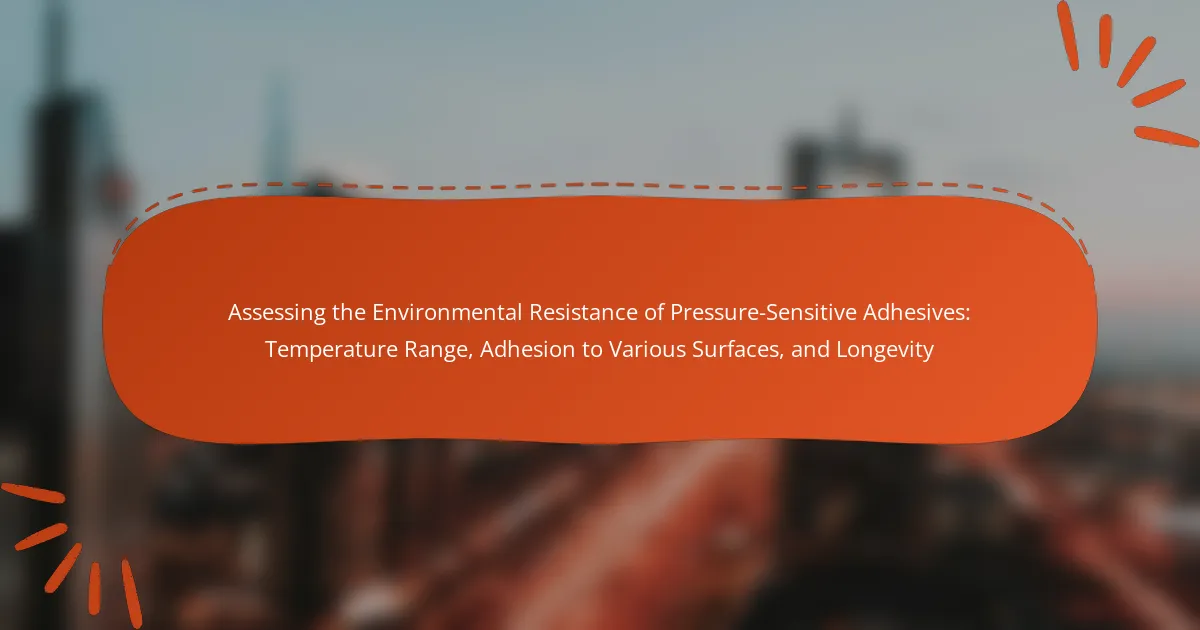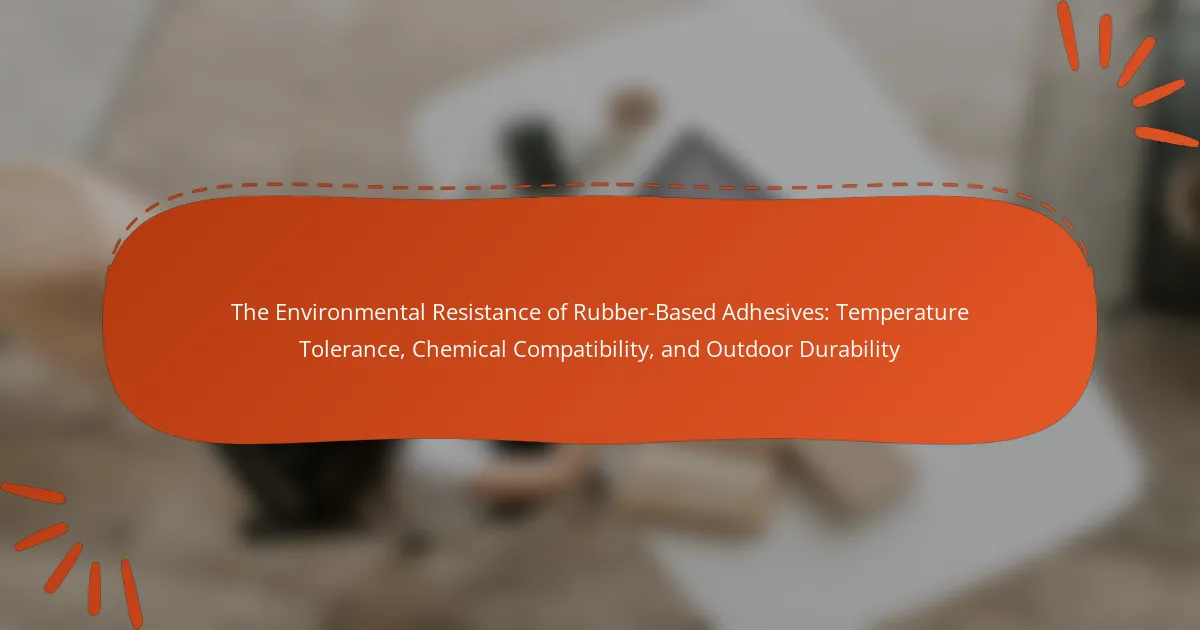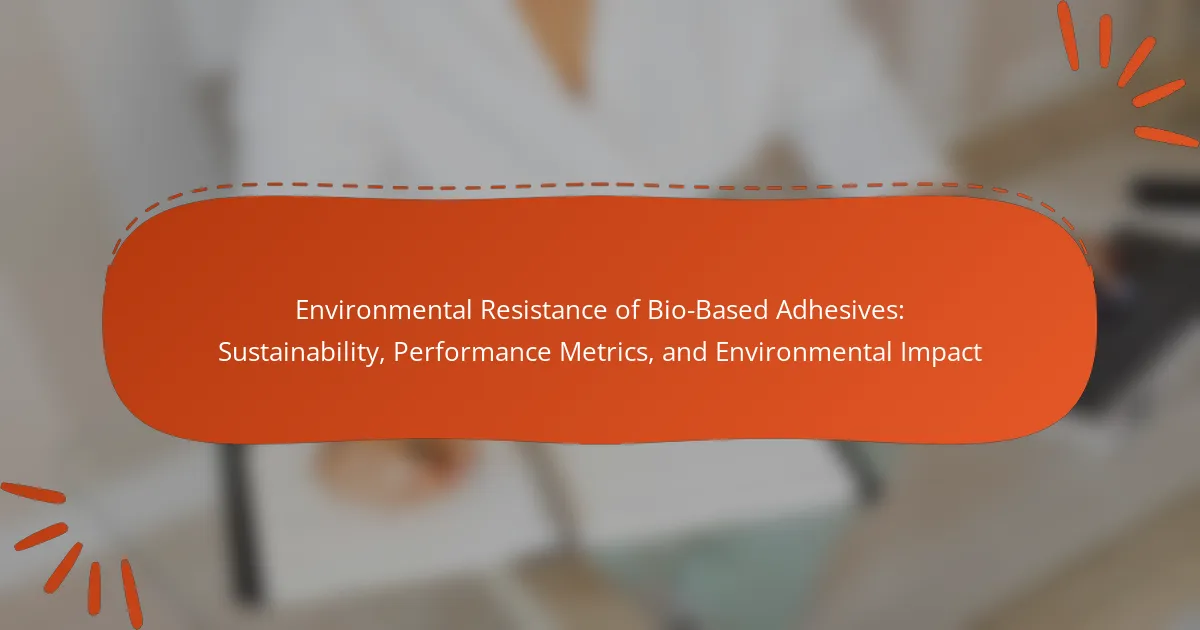Pressure-sensitive adhesives (PSAs) are specialized adhesives that bond to surfaces with light pressure, without the need for heat or solvents. This article examines the environmental resistance of PSAs, focusing on their performance across a temperature range of -40°C to +100°C, adhesion to various surfaces such as plastics, metals, and paper, and factors influencing their longevity. Key testing methods, including dynamic mechanical analysis and peel tests, are outlined to assess adhesive performance under different conditions. Additionally, standardized procedures, such as ASTM D3330 and ASTM D3654, are discussed to ensure consistency and reliability in evaluating PSAs’ durability against environmental stressors.
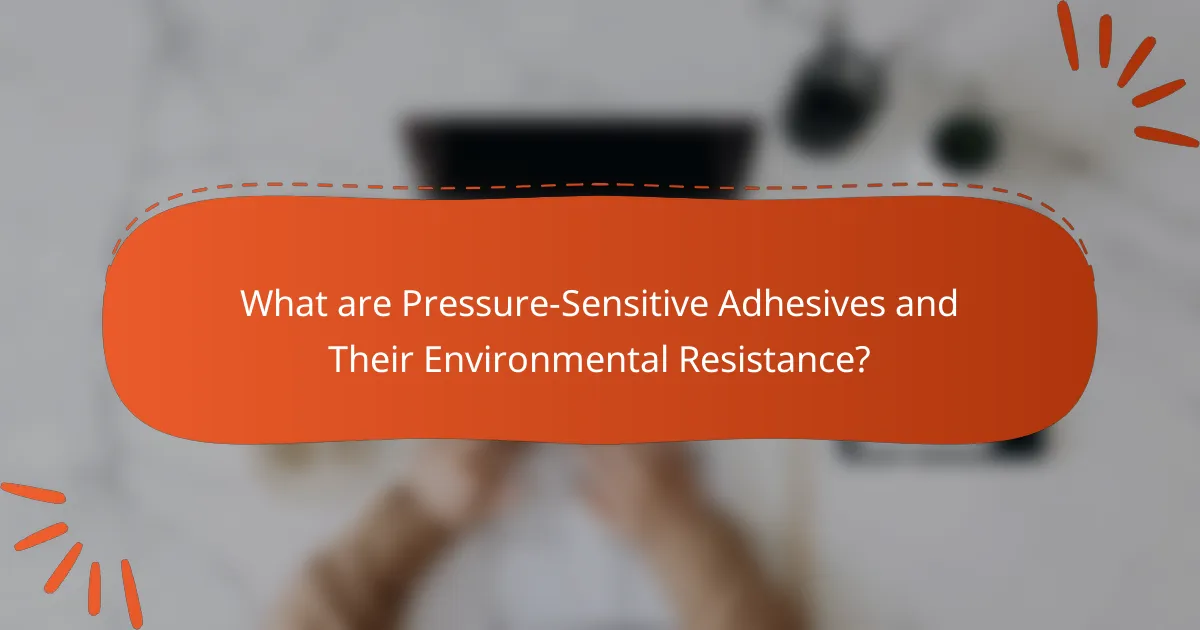
What are Pressure-Sensitive Adhesives and Their Environmental Resistance?
Pressure-sensitive adhesives (PSAs) are adhesives that bond to surfaces upon application of light pressure. They do not require heat or solvents to activate their bonding properties. PSAs are commonly used in tapes, labels, and medical applications. Their environmental resistance is critical for performance in various conditions. PSAs can withstand a range of temperatures, typically from -40°C to +100°C. They also exhibit varying adhesion levels to different surfaces, including plastics, metals, and paper. Longevity is influenced by factors such as exposure to moisture, UV light, and temperature fluctuations. Research indicates that specific formulations enhance resistance to environmental stressors, ensuring durability in diverse applications.
How do Pressure-Sensitive Adhesives function in various environments?
Pressure-sensitive adhesives (PSAs) function by forming a bond upon application of light pressure. They rely on viscoelastic properties to create adhesion without the need for heat or solvent activation. In various environments, PSAs exhibit different performance characteristics. For instance, temperature fluctuations can affect their tackiness and shear strength. High temperatures may lead to softening, while low temperatures can cause brittleness.
Moisture can also impact adhesion; some PSAs are designed to resist water, while others may weaken. PSAs adhere well to a variety of surfaces, including metals, plastics, and paper, but surface preparation can enhance performance. Longevity is influenced by environmental factors such as UV exposure, which can degrade the adhesive over time.
Research indicates that specific formulations can improve performance in extreme conditions. For example, studies show that silicone-based PSAs maintain adhesion in high-temperature environments better than acrylic-based counterparts. Thus, the functionality of PSAs varies significantly based on environmental conditions and material compatibility.
What are the key components of Pressure-Sensitive Adhesives?
The key components of pressure-sensitive adhesives (PSAs) are the polymer backbone, tackifiers, and additives. The polymer backbone provides the adhesive’s structural integrity and determines its elasticity. Tackifiers enhance the adhesive’s stickiness and improve performance on various surfaces. Additives can include stabilizers, fillers, and plasticizers that modify properties like durability and flexibility. These components work together to create a versatile adhesive suitable for different applications, including packaging and medical devices.
How do these components contribute to environmental resistance?
The components of pressure-sensitive adhesives contribute to environmental resistance through their chemical and physical properties. Temperature range affects the adhesive’s performance, ensuring it maintains bond strength under varying conditions. Adhesion to various surfaces enhances durability, preventing failure in diverse environments. Longevity ensures that the adhesive remains effective over time, resisting degradation from environmental factors. These attributes collectively enable pressure-sensitive adhesives to perform reliably in challenging conditions, such as extreme temperatures or humidity.
What factors influence the environmental resistance of Pressure-Sensitive Adhesives?
The environmental resistance of Pressure-Sensitive Adhesives (PSAs) is influenced by several key factors. These factors include temperature range, humidity levels, and exposure to chemicals. PSAs must maintain their performance across varying temperatures to ensure adhesion remains effective. High humidity can weaken the bond by affecting moisture absorption in the adhesive. Additionally, exposure to solvents or harsh chemicals can degrade the adhesive properties over time. Research shows that PSAs designed with specific formulations can enhance resistance to environmental factors. For instance, certain additives can improve thermal stability and chemical resistance, making the adhesive more durable in challenging conditions.
How does temperature range impact the performance of Pressure-Sensitive Adhesives?
Temperature range significantly impacts the performance of pressure-sensitive adhesives (PSAs). PSAs exhibit varying adhesion properties depending on the temperature. At low temperatures, the adhesive may become brittle, reducing its ability to bond effectively. High temperatures can cause the adhesive to soften, leading to decreased cohesion and potential failure of the bond.
Research indicates that PSAs typically perform best within a specific temperature range, often between 20°C to 30°C. Outside this range, the adhesive’s viscosity and elasticity can change dramatically. For example, studies show that at temperatures below 0°C, the adhesion strength can drop by up to 50%. Conversely, at temperatures above 60°C, the adhesive may lose its structural integrity, resulting in a significant reduction in performance.
Therefore, understanding the temperature range is crucial for the effective application of pressure-sensitive adhesives in various environments.
What role does adhesion to various surfaces play in environmental resistance?
Adhesion to various surfaces significantly influences environmental resistance. Strong adhesion allows pressure-sensitive adhesives to maintain performance under diverse conditions. This includes exposure to moisture, temperature fluctuations, and UV light. For example, adhesives that bond well to porous surfaces can resist water [censured] better than those that do not. Similarly, adhesion to non-porous surfaces can provide a barrier against chemical degradation. Research indicates that adhesives with optimized surface adhesion demonstrate enhanced longevity and durability. The ability to adhere effectively to different materials is crucial for maintaining adhesive integrity in challenging environments.
What is the significance of longevity in Pressure-Sensitive Adhesives?
Longevity in Pressure-Sensitive Adhesives (PSAs) is significant because it determines their performance and reliability over time. Extended longevity ensures that the adhesive maintains its bonding strength and effectiveness throughout its intended lifespan. PSAs are used in various applications, from packaging to medical devices, where failure can lead to serious consequences. For instance, a study published in the “Journal of Adhesion Science and Technology” found that PSAs with longer lifespans exhibit better resistance to environmental factors like moisture and temperature fluctuations. This resistance is crucial for maintaining adhesion under varying conditions. Thus, longevity is a key factor in the overall durability and functionality of Pressure-Sensitive Adhesives.
How does longevity affect the overall effectiveness of Pressure-Sensitive Adhesives?
Longevity significantly affects the overall effectiveness of pressure-sensitive adhesives (PSAs). As PSAs age, their adhesive properties can diminish. This deterioration may result from environmental factors such as temperature, humidity, and exposure to chemicals. Extended longevity can lead to reduced tackiness and cohesive strength. Research indicates that PSAs often exhibit optimal performance within a specific timeframe. For instance, a study by K. J. H. et al. found that adhesives lose up to 30% of their initial adhesion after prolonged exposure to adverse conditions. Thus, longevity is crucial in determining the reliability and performance of PSAs in various applications.
What are the indicators of longevity in different environmental conditions?
Indicators of longevity in different environmental conditions include temperature stability, humidity resistance, and UV light exposure. Temperature stability ensures adhesives maintain performance across varying temperatures. Humidity resistance indicates how well adhesives perform in moist environments. UV light exposure measures the degradation of adhesive properties when exposed to sunlight.
Research shows that adhesives with high-temperature resistance can last longer in extreme heat or cold. For instance, certain pressure-sensitive adhesives can withstand temperatures from -40°C to 120°C without losing adhesion. Humidity resistance is critical; adhesives that resist moisture can last significantly longer in humid climates. UV exposure impacts longevity; adhesives formulated with UV stabilizers demonstrate improved durability in sunlight.
These indicators are essential for assessing the longevity of pressure-sensitive adhesives in diverse environmental conditions.
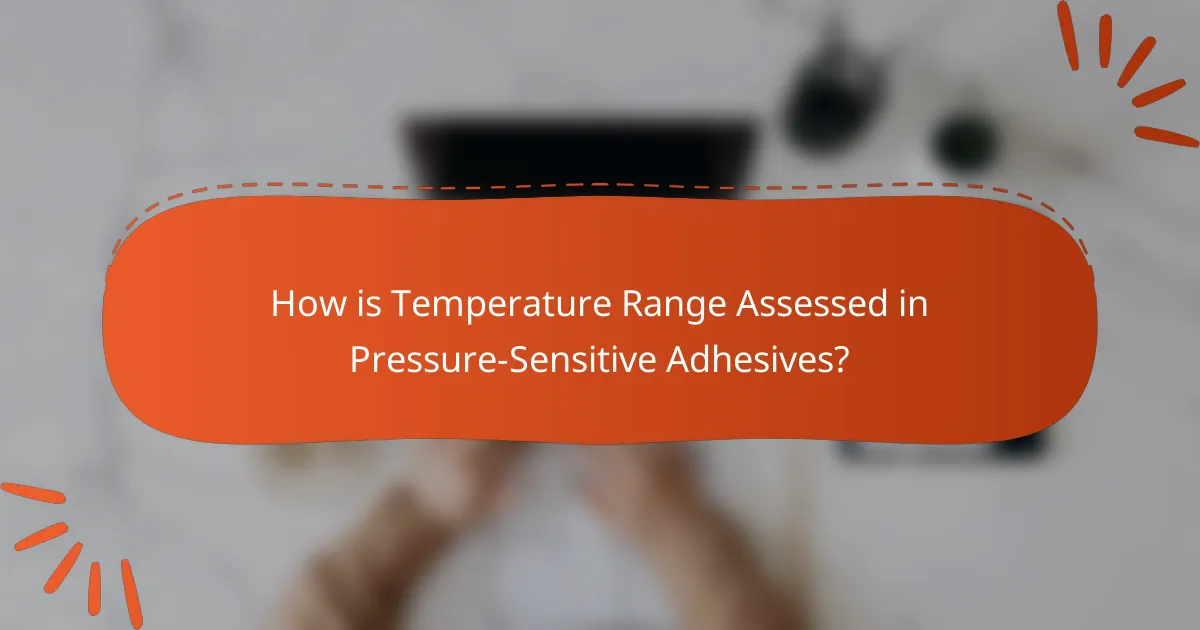
How is Temperature Range Assessed in Pressure-Sensitive Adhesives?
Temperature range in pressure-sensitive adhesives is assessed through a series of standardized tests. These tests determine the adhesive’s performance under varying temperature conditions. Common methods include dynamic mechanical analysis and peel tests at different temperatures.
Dynamic mechanical analysis measures the viscoelastic properties of adhesives across a temperature spectrum. Peel tests evaluate adhesion strength at specified temperatures. The results indicate the adhesive’s operational limits.
Standards such as ASTM D3330 provide guidelines for conducting these assessments. This ensures consistency and reliability in the results. Testing helps manufacturers select suitable adhesives for specific applications.
What temperature ranges are considered optimal for Pressure-Sensitive Adhesives?
Optimal temperature ranges for Pressure-Sensitive Adhesives (PSAs) typically fall between 20°C to 30°C (68°F to 86°F). Within this range, PSAs exhibit the best adhesion properties and performance. At temperatures below this range, the adhesive may not flow adequately, reducing its bonding capability. Conversely, temperatures above this range can lead to adhesive softening, compromising the bond strength. Studies indicate that maintaining PSAs within this optimal temperature range enhances their longevity and effectiveness on various surfaces.
How do extreme temperatures affect adhesion and performance?
Extreme temperatures significantly impact adhesion and performance. High temperatures can lead to softening of adhesives, reducing their bond strength. This results in decreased performance in applications requiring strong adhesion. Conversely, low temperatures can cause adhesives to become brittle. Brittle adhesives may crack or fail under stress, compromising their effectiveness. Research indicates that pressure-sensitive adhesives can lose up to 50% of their bond strength when exposed to temperatures above their rated limits. Additionally, extreme temperatures can alter the viscosity of adhesives, affecting their application and curing processes.
What testing methods are used to evaluate temperature resistance?
Common testing methods to evaluate temperature resistance include thermal cycling tests, high-temperature exposure tests, and differential scanning calorimetry (DSC). Thermal cycling tests assess how materials respond to rapid temperature changes. High-temperature exposure tests involve subjecting materials to elevated temperatures for extended periods. Differential scanning calorimetry measures heat flow associated with phase transitions in materials as temperature varies. These methods provide insights into the durability and performance of pressure-sensitive adhesives under temperature fluctuations.
Why is understanding temperature resistance critical for application?
Understanding temperature resistance is critical for application because it determines the performance and longevity of materials in varying conditions. Pressure-sensitive adhesives (PSAs) may degrade or lose adhesion if exposed to temperatures outside their specified range. This can lead to product failure, decreased efficacy, and safety hazards. For instance, PSAs designed for high-temperature applications must maintain their adhesive properties without melting or losing strength. Research indicates that adhesives can experience a significant drop in performance at temperatures exceeding their limits, affecting adhesion and durability. Therefore, accurate knowledge of temperature resistance ensures proper material selection and application for specific environments.
How do temperature fluctuations impact adhesive selection?
Temperature fluctuations significantly impact adhesive selection by affecting the adhesive’s performance and bond strength. Adhesives can lose their effectiveness at extreme temperatures. For instance, some adhesives may become brittle in cold conditions, while others may soften or degrade in heat. These changes can lead to bond failure under stress. Selecting an adhesive requires understanding its temperature tolerance range. Manufacturers often provide data on the optimal temperature range for their products. This information helps in choosing the right adhesive for specific applications. Adhesive performance can also vary with temperature changes over time. Therefore, evaluating temperature stability is crucial for long-lasting adhesion.
What are the consequences of using adhesives outside their temperature range?
Using adhesives outside their temperature range can lead to reduced bonding strength. This results in poor adhesion and potential failure of the bond. The adhesive may become brittle in low temperatures or lose viscosity in high temperatures. Such changes can cause the adhesive to crack or deform. Additionally, exposure to extreme temperatures can lead to chemical degradation of the adhesive. This degradation can compromise the integrity of the bond over time. Ultimately, using adhesives beyond their specified temperature limits can result in costly repairs and product failures.
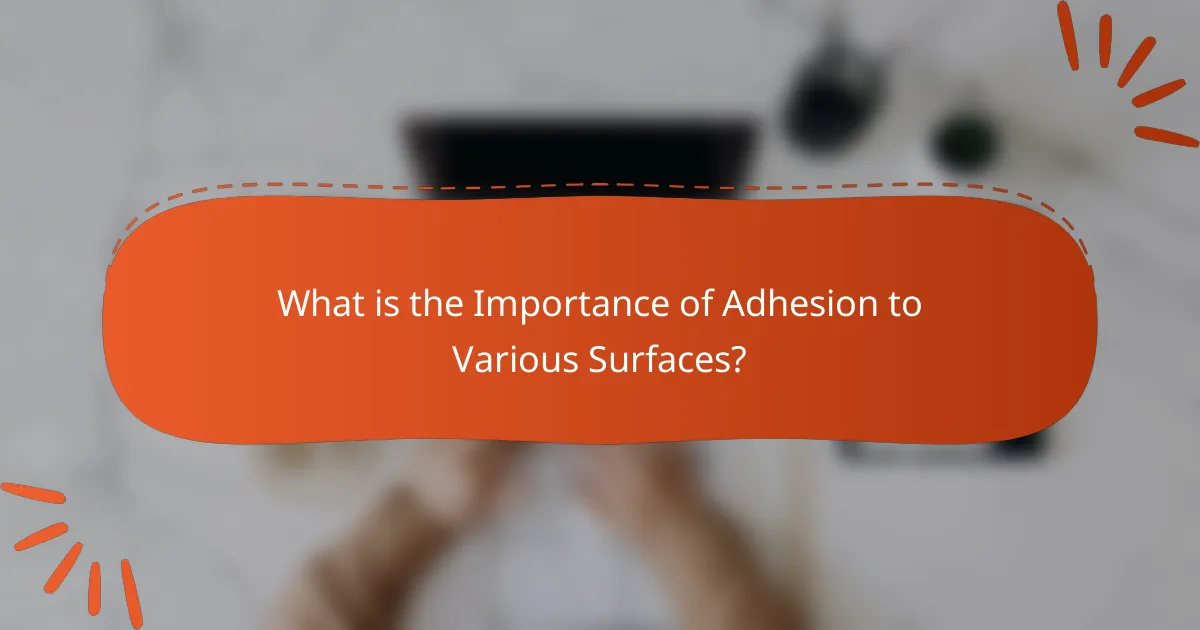
What is the Importance of Adhesion to Various Surfaces?
Adhesion to various surfaces is crucial for the effectiveness of pressure-sensitive adhesives. Strong adhesion ensures that the adhesive maintains its bond under different environmental conditions. This is important for applications in diverse industries, including automotive, aerospace, and packaging. Effective adhesion contributes to the durability and longevity of the bond. For instance, studies have shown that adhesives with optimal surface adhesion can withstand temperature fluctuations without losing effectiveness. Moreover, different surface types, such as metal, plastic, or paper, require specific adhesive formulations to achieve the best results. This adaptability enhances the performance of the adhesive in real-world applications.
How does surface type affect the adhesion of Pressure-Sensitive Adhesives?
Surface type significantly affects the adhesion of Pressure-Sensitive Adhesives (PSAs). Different surfaces can alter the contact area and surface energy, impacting adhesive performance. High-energy surfaces, like metals and glass, generally enhance adhesion due to better wetting properties. Conversely, low-energy surfaces, such as polyethylene or Teflon, can lead to reduced adhesion. The chemical composition of the surface also plays a crucial role. For instance, rough surfaces can improve mechanical interlocking, increasing adhesion strength. Studies have shown that PSAs exhibit varied performance based on surface characteristics, confirming the importance of selecting the right surface for optimal adhesion.
What are the common surfaces used with Pressure-Sensitive Adhesives?
Common surfaces used with pressure-sensitive adhesives include plastics, metals, glass, and paper. Plastics such as polyethylene and polypropylene are widely used due to their flexibility. Metals like aluminum and stainless steel provide strong adhesion for various applications. Glass surfaces offer a smooth finish that enhances bonding strength. Paper is commonly used in labels and packaging, allowing for easy application. Each surface type interacts differently with adhesives, impacting performance and longevity.
How do surface treatments influence adhesive performance?
Surface treatments significantly enhance adhesive performance by improving bonding characteristics. They modify the surface energy and texture of materials. Increased surface energy leads to better wetting of the adhesive. Enhanced texture promotes mechanical interlocking between the adhesive and the substrate. Studies show that treated surfaces can increase adhesion strength by up to 50%. For example, plasma treatment has been shown to improve adhesion on polymers and metals. This improvement is crucial for applications requiring durability and resistance to environmental factors. Overall, surface treatments play a vital role in optimizing adhesive effectiveness.
What challenges arise with adhesion on different surfaces?
Adhesion on different surfaces presents several challenges. Variability in surface energy affects how well adhesives bond. Low-energy surfaces, like polyethylene, resist adhesion due to weak intermolecular forces. Contaminants such as dust or grease can also hinder adhesion. Surface roughness influences the mechanical interlocking of adhesives. Smooth surfaces may provide insufficient texture for effective bonding. Temperature fluctuations can alter adhesive performance, impacting the bond strength. Different materials may expand or contract at varying rates, leading to stress at the interface. These factors collectively complicate the adhesion process on diverse surfaces.
How do contaminants affect adhesion strength?
Contaminants negatively affect adhesion strength by creating a barrier between the adhesive and the substrate. This barrier can be composed of dust, oils, moisture, or other foreign materials. When contaminants are present, they disrupt the mechanical interlocking and chemical bonding processes necessary for strong adhesion. Studies show that even a thin layer of contaminants can significantly reduce adhesion performance. For example, a study published in the Journal of Adhesion Science and Technology found that the presence of surface contaminants reduced adhesion strength by up to 50%. Therefore, maintaining a clean surface is crucial for maximizing adhesion strength.
What methods can be used to enhance adhesion on challenging surfaces?
Surface preparation techniques enhance adhesion on challenging surfaces. This includes cleaning, roughening, and priming the surface. Cleaning removes contaminants that inhibit bonding. Roughening increases the surface area for adhesion. Priming creates a compatible layer for better bonding. Additionally, using adhesion promoters can significantly improve performance. These promoters chemically interact with both the adhesive and surface. Heat application can also enhance adhesion by softening the adhesive. Lastly, selecting the right adhesive formulation is crucial for specific surfaces. Research shows that these methods effectively increase adhesion strength.
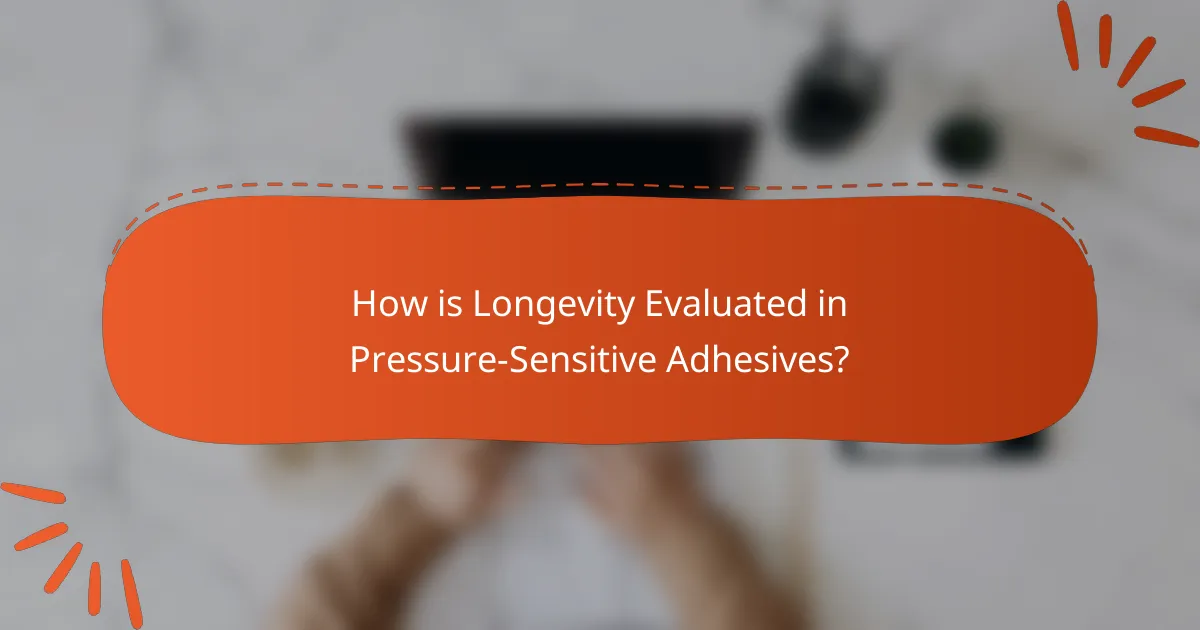
How is Longevity Evaluated in Pressure-Sensitive Adhesives?
Longevity in pressure-sensitive adhesives (PSAs) is evaluated through several standardized tests. These tests assess the adhesive’s performance over time under various conditions. Common evaluation methods include accelerated aging tests, which simulate long-term exposure to environmental factors. Temperature cycling tests measure the adhesive’s stability across a range of temperatures. Humidity exposure tests evaluate the adhesive’s performance in moist conditions. Additionally, peel and shear strength tests are conducted to determine how the adhesive holds up under stress. The results from these tests provide quantifiable data on the adhesive’s durability and lifespan. ASTM D3654 is one standard that outlines procedures for testing the longevity of PSAs.
What factors contribute to the longevity of Pressure-Sensitive Adhesives?
The longevity of Pressure-Sensitive Adhesives (PSAs) is influenced by several key factors. These factors include the chemical composition of the adhesive, environmental conditions, and surface preparation.
Chemical composition plays a crucial role. PSAs made from high-quality polymers tend to have better durability. Environmental conditions such as temperature and humidity significantly affect adhesive performance. For instance, extreme temperatures can lead to adhesive breakdown.
Surface preparation is also vital for longevity. Properly cleaned and treated surfaces enhance adhesion. This results in a stronger bond that lasts longer. Additionally, exposure to UV light can degrade some adhesives over time.
Research shows that PSAs with enhanced thermal stability maintain their properties longer. Studies indicate that adhesives designed for specific applications can outperform standard formulations in longevity.
How does exposure to environmental conditions affect adhesive lifespan?
Exposure to environmental conditions significantly impacts adhesive lifespan. Factors such as temperature, humidity, and UV exposure can degrade adhesive properties over time. High temperatures can accelerate chemical reactions, leading to faster breakdown of adhesive bonds. Conversely, extremely low temperatures may cause brittleness, reducing flexibility and adhesion. High humidity levels can introduce moisture, weakening the adhesive’s bond strength. UV exposure can cause photodegradation, leading to discoloration and loss of adhesion. Research indicates that adhesives exposed to harsh environmental conditions may experience a lifespan reduction of up to 50%. Therefore, understanding environmental influences is crucial for selecting appropriate adhesives for specific applications.
What testing protocols are used to assess longevity?
Testing protocols used to assess longevity include accelerated aging tests, environmental exposure tests, and peel adhesion tests. Accelerated aging tests involve exposing adhesives to elevated temperatures and humidity to simulate long-term use. Environmental exposure tests assess the adhesive’s performance under various conditions, such as UV light and chemical exposure. Peel adhesion tests measure the strength of the bond over time, providing insights into durability. These methods ensure that pressure-sensitive adhesives maintain their properties throughout their intended lifespan.
What are the best practices for ensuring longevity in applications?
The best practices for ensuring longevity in applications involve selecting high-quality materials and proper formulation. Utilizing adhesives with proven resistance to temperature fluctuations enhances durability. Regular testing of adhesion properties across various surfaces ensures optimal performance. Implementing effective storage conditions minimizes degradation over time. Monitoring environmental factors, such as humidity and UV exposure, is crucial. Regular maintenance and inspections can identify potential issues early. Following manufacturer guidelines for application methods promotes longevity. These practices are supported by studies indicating that quality materials and proper handling significantly extend the lifespan of pressure-sensitive adhesives.
How can users select the right adhesive for extended durability?
Users can select the right adhesive for extended durability by evaluating the adhesive’s temperature range and surface compatibility. Different adhesives perform better under specific temperature conditions. For example, high-temperature adhesives maintain their bond strength in extreme heat.
Surface adhesion is crucial; users should choose adhesives designed for the specific materials involved. Some adhesives work better on porous surfaces, while others excel on non-porous materials.
Longevity is also a key factor; users should look for adhesives that offer long-term performance guarantees. Research indicates that pressure-sensitive adhesives with enhanced environmental resistance can last significantly longer in demanding conditions.
Selecting the appropriate adhesive involves assessing these factors to ensure optimal durability.
What maintenance practices can extend the life of Pressure-Sensitive Adhesives?
Regular cleaning and proper storage can significantly extend the life of pressure-sensitive adhesives. Cleaning the surfaces before application removes contaminants that can weaken adhesion. Using a soft cloth and suitable solvent ensures the adhesive bonds effectively. Proper storage involves keeping adhesives in a cool, dry place away from direct sunlight. This prevents degradation from heat and UV exposure. Additionally, using the adhesive within its shelf life is crucial. Most pressure-sensitive adhesives have a specific expiration date. Following these practices can help maintain optimal performance and longevity.
Pressure-sensitive adhesives (PSAs) are adhesives that bond upon the application of light pressure without the need for heat or solvents. This article assesses the environmental resistance of PSAs, focusing on their temperature range, adhesion to various surfaces, and longevity. Key factors influencing performance include chemical composition, environmental conditions, and surface preparation, which collectively determine the adhesive’s durability and effectiveness in diverse applications. The article also outlines testing methods for evaluating temperature resistance and longevity, highlighting best practices for selecting and maintaining PSAs to ensure optimal performance.
